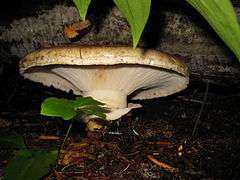Catathelasma imperiale
Catathelasma imperiale is a large species of mushroom in the family Tricholomataceae. It is found in North America and Europe.[2] It is also found and consumed in Bhutan.[3]
| Catathelasma imperiale | |
|---|---|
 | |
| Scientific classification | |
| Kingdom: | |
| Division: | |
| Class: | |
| Order: | |
| Family: | |
| Genus: | |
| Species: | C. imperiale |
| Binomial name | |
| Catathelasma imperiale | |
| Synonyms[1] | |
|
1845 Agaricus imperialis Fr. | |
| Catathelasma imperiale | |
|---|---|
float | |
| gills on hymenium | |
| cap is convex or depressed | |
| hymenium is decurrent | |
| stipe has a ring | |
| spore print is white | |
| ecology is mycorrhizal | |
| edibility: edible | |
Description
The following description combines several references.[4][5][6][7][8][9]
- Cap: 8 – 40 cm, orange brown to hazel brown, with darker patches. Often remaining closed up with a domed shape, but sometimes expanding and finally depressed.
- Gills: Whitish, decurrent, crowded, sometimes forked.
- Stem: Pale brown with two rings. Tapering below, often partly buried.
- Odor: Of flour,[4][6][7] cucumber[5][9] or unripe melon skin.[8]
- Spores: White (en masse), 10 - 15 x 5 - 6 μm,[7] smooth, somewhat spindle-shaped, amyloid.
- Habitat: Under conifers, especially Pine and Spruce, in mountainous regions.
European sources give the cap size as up to about 20 cm,[4][5][6][8] while North American ones indicate an enormous maximum size of 40 cm.[7][10]
The upper ring is derived from the partial veil (which covered the lower surface of the cap before it opened), whereas the thinner lower ring originally formed part of the universal veil (which enveloped the whole mushroom).[11]
Taxonomy and Related Species
C. imperiale is the only species of Catathelasma known in Europe. It was first described in 1845 by Fries under the name Agaricus imperialis. In 1872 Quélet classified the species in Armillaria and in 1922 the Austrian botanist Günther Beck von Mannagetta und Lerchenau invented the separate genus Biannularia for this single species, making it Biannularia imperialis. The genus Catathelasma had been defined in 1910 by Ruth Ellen Harrison Lovejoy[12] based on the American species C. evanescens and for a time the two genera were regarded as separate (though closely related), as for instance in a 1936 paper by Rolf Singer.[13] A few years later in 1940, Singer united the genus[14] using Lovejoy's name, which takes precedence.
The epithet "imperiale", meaning "imperial" refers to the (at times) large size of the mushroom. The species name must end in "-e", not "-is", as the genus is neuter.[15]
General
In Europe this species has something of an iconic status amongst mycologists as an impressive and remarkable mushroom to find.
It occurs in western North America[7] and in various European countries (mainly in central Europe) where its frequency varies from "fairly rare" to "rare".[5]
C. imperiale is edible,[16] but tough-fleshed. It is said to be good pickled.[2]
References
- "Catathelasma imperiale (Quél.) Singer 1940". MycoBank. International Mycological Association. Retrieved 2010-12-09.
- Wood S, Stevens F. "Catathelasma imperiale". California Fungi. Retrieved 2012-03-11.
- "Bhutan Mushroom Tours". Mushroaming. Bhutan Mushroom Tours. Retrieved 2020-08-03.
- Marcel Bon (1987). The Mushrooms and Toadstools of Britain and North-Western Europe. Hodder & Stoughton. p. 162. ISBN 0-340-39935-X.
- Courtecuisse, R.; Duhem, B. (1994). Guide des champignons de France et d'Europe. Delachaux et Niestlé. p. 208. ISBN 2-603-00953-2. Also available in English.
- Funga Nordica. Copenhagen: Nordsvamp. 2008. p. 429.
- Kuo, M. (2006, October). Catathelasma imperiale. See the MushroomExpert.Com Web site.
- See Meinhard Moser, translated by Simon Plant (1983). Keys to Agarics and Boleti. 15a Eccleston Square, London: Roger Phillips. p. 150. ISBN 0-9508486-0-3.CS1 maint: location (link)
- See the MycoDB entry (in French).
- See the healing-mushrooms.net entry Archived 2012-04-27 at the Wayback Machine.
- Robert Kühner & Henri Romagnesi (1974). Flore analytique des champignons supérieurs (agarics, bolets, chanterelles) (in French). Paris: Masson. p. 143. ISBN 2-225-53713-5. The mushroom appears here under the name Biannularia.
- Ruth Harrison Lovejoy (1910). "Some New Saprophytic Fungi of the Middle Rocky Mountain Region". The Botanical Gazette. 50: 383. The text can be found on-line in The Internet Archive.
- Rolf Singer (1936). "Das System der Agaricales". Annales Mycologici. 34 (4–5): 317.
- Singer R. (1940). "Notes sur quelques Basidiomycètes". Revue de Mycologie (in French). 5: 3–13.
- The Species Fungorum page shows the full naming history.
- Phillips, Roger (2010). Mushrooms and Other Fungi of North America. Buffalo, NY: Firefly Books. p. 65. ISBN 978-1-55407-651-2.